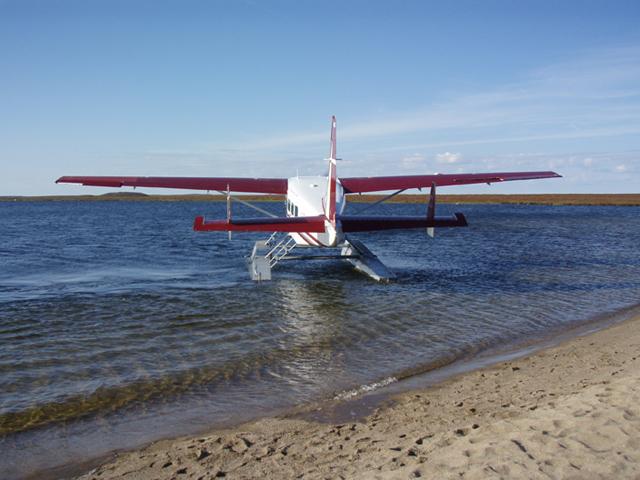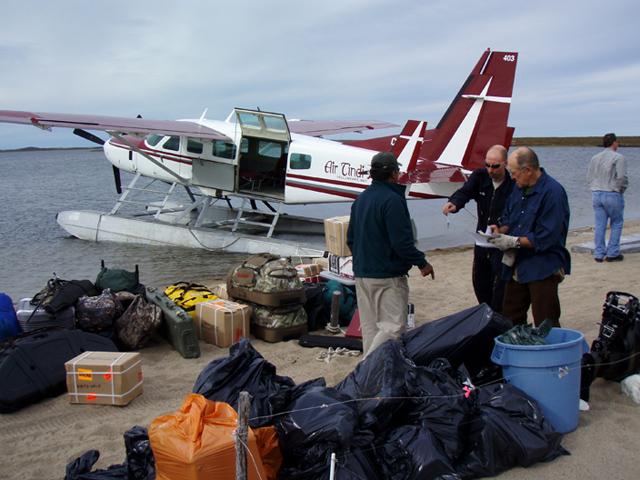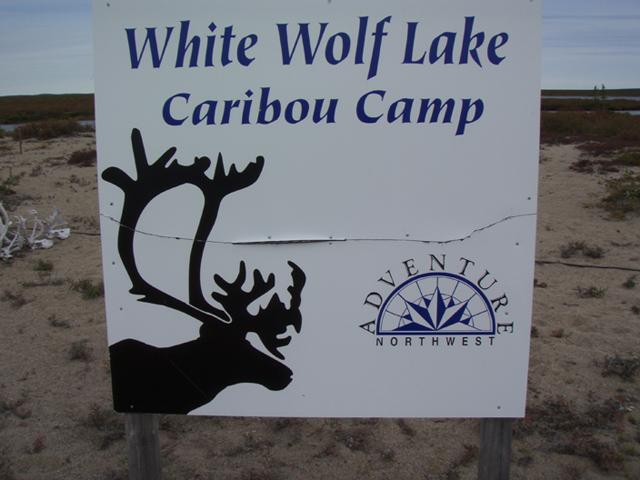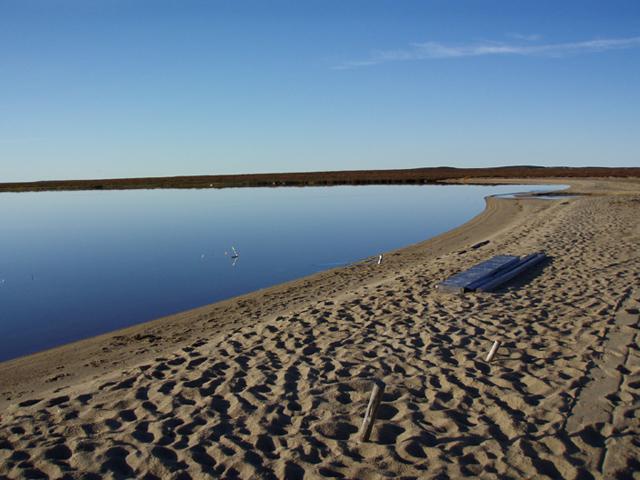28th August
Last night Frank told me that Carlos would collect me at 8.00, and we would fly immediately to the caribou camp. By 8.00 I'm up and ready, as ordered, waiting in the hotel lounge. Then Carlos arrives and informs me that, due to unforseen circmstances, my plane can't leave until noon. I am not surprised by this; so far, nothing has gone according to plan. I go back to my room, and then go out to a nearby fast-food restaurant for breakfast.
I'm waiting for 12.00 to come.
The time finally arrives. The phone rings, and we set off. I am sitting in the minibus with two archers: Jake Ensign and Richard Longoria. During the next few days they will bear witness to all my triumphs and failures. Carlos drives us to the float-plane airport, which is run by some big company; right now, there are three large Cessnas floating on the water. They can carry at least ten people; they are twin-engined Cessna giants. Our bags are placed on wooden pallets and a buggy takes them off to be weighed. They are quite heavy; all three of us have brought as much as we possibly can. The pilot frowns at first, but then relents. Two more passengers arrive, a middle-aged gentleman and a young boy, father and son. We don't know yet, what they are doing here.
The runway is simply a stretch of Great Slave Lake. The planes are tethered in a small bay, and we have to taxi out from here. Our bags take up a large part of the cabin - there's a lot to carry. I can see that, besides our equipment, we are taking a lot of provisions. Boxes are even placed in the hollow sections of the floats, and the loaders carefully utilise every bit of space. After packing and securing all the bags in the cabin, they then try to find room for the seats, which are screwed into place.
Slowly we get ready to take off...



Chapter IV.: Caribou hunting in the Northwest Territories
Page 3
I get in; I can't stretch my legs because of all the bags - space is very tight. The pilot starts the engine and, slowly and smoothly, we glide across the lake. We look for a suitable wind. The pilot opens the throttle, the huge machine races across the lake like a motor-boat, and suddenly we are airborne. We sweep through the sky over Yellowknife, and fly over Frame Lake. This is the lake I walked around during my enforced vacation, when I first arrived. We pass over the now-familiar tundra, with all its many lakes and marshes, for more than an hour. I'm starting to get a little bored of all this flying, so I sleep for most of the journey. Yellowknife is 175 miles behind us, when we suddenly come down to land on a quite sizeable lake. I can't see any harbour or pier.
We approach the shore, the pilot reverses the plane, and the floats are smoothly beached on the sandy shore.
We seem to have arrived.


Chapter IV.: Caribou hunting in the Northwest Territories
Page 4
The bags and boxes are passed from one hand to another as we quickly unload the plane. The name of our camp is White Wolf Lake Caribou Camp. As the name suggests, the lake is called White Wolf Lake.
There is even a sign up, proudly displaying its name and emblem. It is slightly reminiscent of Kavik Camp, but more run-down and less well-equipped. Nothing is produced here; we are entirely reliant on our supplies. There is even an ATV - or honda, as the Inuits say - which is used to carry things around the camp. There are four boats on the shore, two with engines, ready for use.
We are staying in a strange combination of a tent and a wooden cabin. There is a temporary structure of canvas stretched over wooden frames, which make up the walls, and inside are hard, wooden beds with mattresses, on a plank floor. We three hunters are to occupy this single barrack, and there is even a desk, which I claim at once (the others aren't keeping diaries).
In theory there is electricity, as the generator is humming away, but we have not been able to switch on the solitary lighbulb. It's doubtful if I'll be able to recharge any of my batteries, and showers, and any other form of washing, will have to be indefinitely postponed. The camp is half-full, and there are several other cabins which are not yet completed - they haven't even put up the canvas. No-one is living in them, but we don't know why. After we have unpacked and settled in, Pat, the director of the camp, with his head guide, give us a short briefing in the dining area.
I've been told that he will be my guide, which I'm quite pleased about. He is a mature man, of about 60, apparently a very experienced guide, who, amongst other things, has guided the founder of Cabela's, the great Jim Cabela, when he came to this part of the country. He tells us that yesterday there were several hundred caribou in the vicinity, but that a week ago there were several thousand. Soon after we arrived, using the spotting scope provided by the camp, we had already seen one cow, despite the fact that, on our canvas wall,there was an indignant message from a previous occupant saying that, even though he had paid out $6000, he had managed to bag nothing more than a local bird during his stay. He was not a happy man, as was made clear to the reader by his use of several rather rude English expressions. But Pat, however, is optimistic. He says that nearby caribou do not migrate from one place to another, as is normal, but instead walk around in a vast circle, which they hardly ever leave.



Chapter IV.: Caribou hunting in the Northwest Territories
Page 5
As I left the hotel, Carlos handed me an envelope, saying that it contained the permits and the tag for my second caribou. I'm now catching up with my paperwork, so I open the envelope. To my surprise, I find that it contains a permit to shoot a wolf. I'm completely mystified, as I will not shoot wolves. Even if there was one lying on my doorstep, I still wouldn't hurt it. I wrote to Frank at the start, telling him to remove wolves from all my hunts; if I'm not going to shoot them, why should I buy a permit? I know that he did so, as I can see in the accounts on my computer that wolves, and the charges for their permits, have been removed. But I still have this permit. I've never heard of a hunter getting more permits than he paid for. What are things coming to! Pat also mentions that if any of us had intended taking away the lower jawbone of a caribou, we must forget it at once, as these must all be handed in to the authorities. Scientists are carrying out various analyses of caribou and require this part of their anatomy to make them. I couldn't care less; all I want to take are the antlers, and they are welcome to analyse whatever is left.



Chapter IV.: Caribou hunting in the Northwest Territories
Page 6
An unfortunate event occurs that disturbs our hunting preparations. The middle-aged man who flew in with us - we still don't know why - wants to try out Ricardo's bow. There's a little problem: he wants to do it right here in the tent. A bigger problem is that he knows nothing about bows.
And the biggest problem is that he pretends that he does. He draws the bow, and then, using the wrong technique, and without an arrow, he releases the string. There's an awful cracking sound and something snaps off the bow, flying across the room like a bullet, barely missing our heads.
Ricardo is flabbergasted.
The bow is now unusable.
In a moment the man has destroyed a weapon that cost $2000, and was made to order. It can be repaired, but until then it is unusable. Ricardo accepts the loss with unbelievable calmness, and without showing any emotion, produces another bow from his bag.
This is his spare; if anything happens to this one, his hunting is over.
I think I might keep my Peli bag locked from now on. With people like this on the loose, all guns


Chapter IV.: Caribou hunting in the Northwest Territories
Page 7
and weapons could become rather dangerous.
Behind the camp stands a pole, called the rifle-range, with some tattered old targets hanging from it. It's all I need, and I decide to test my gun immediately. We rig up a new target holder and put a fresh target on it. With my laser I measure out 100 meters (330 ft.), and place the target there.
This makes the range usable not only for those who like yards, but also for people who prefer the metric system. I set the sight, put on my earmuffs, and start shooting!
I take one shot, and can't believe my eyes.
I aimed at the lower part of the bulls-eye, just as I did at Kavik. The bullet should have hit the ten-mark. Over a range of 100m. you have to adjust your aim to compensate for the bullet's flight.
But, in fact, the bullet has hit the very top of the sheet: I'm barely on the target. And, what is especially annoying, is that I am 2cm, nearly an inch, to the right. I take two more test shots, and the holes are still in the same place. In the words of an old beer advert: it's time to think.
I'm certain that I was shooting correctly. My gun-rest was perfect, and I was in a comfortable sitting position when firing. The fault must be with the sight settings. But how, and when, could the sight have been altered? It couldn't have happened while it was in the case. I do remember bumping it once or twice when I was in Alaska, but I never thought it would have any serious consequences. But, after these three shots, I must reasses what's been happening, and that includes my missed musk ox-shot. When I bagged my first musk ox, my initial shot also went too high. If I accept that over 100m. the bullet deviates by 10cm - and judging by the results, that's a conservative estimate - then over 300m. (1000ft) it is bound to miss the target. Even if it is a big ox, that is too much deviation. Disregarding all this, it wasn't a very well set up shot; but, without trying to minimise my own shortcomings, I just want to establish what other factors might have led to the mistake. I adjust the setting, and finall my shots start going where I want them to. After two more confirmatory shots I start to relax; but I have used up eight bullets. I have three more boxes of ammunition sitting in Anchorage, but I shan't be back there for a while. I have just one box with me for the two caribou here, and the antelope hunt in Montana.
It will have to do.
At least, I hope it will...
After my test shots, Pat calls me over to the spotting scope. I can see ten caribou moving about, but today I'm not allowed to hunt any of them. The rule that there is no hunting on your day of arrival applies here too. Interestingly, up with the Inuits, they either didn't have this law, or just ignored it. So I can do nothing but drool over the sight of a particularly fine stag. I can't judge its antlers, but according to Pat, it is a mature, shootable animal.



Chapter IV.: Caribou hunting in the Northwest Territories
Page 8
For dinner, Pat roasts some meat, with three types of garnish, and makes an isotonic drink from some powder. After this, we all devour a huge cake. We will have lots of energy for tomorrow's hunt.
We take in the sunset.
A pump-action Mossberg shotgun is leaning against the door of the barracks. Whoever has to answer the call of nature during the night must only do so with this gun in his hands.
Bears!
White Wolf Lake Caribou Camp



















